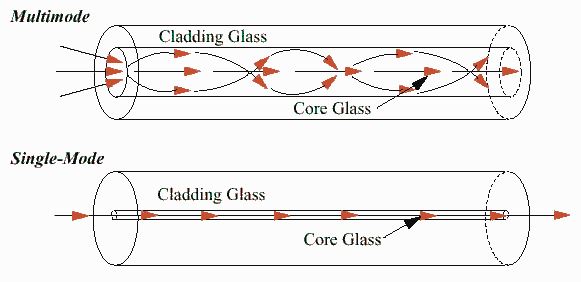Single mode vs. Multimode – What is the difference?
When shopping for Fibre Optic Cable, the first question you will usually be asked is ‘What mode of cable do you require?’ For new installers and users, often the answer is “I Don’t Know.” You are not sure how to get answers? Help is available at Fibre Optic Systems.
In this article, we will explain to you the key information required to understand the differences between singlemode vs multimode. We will focus on the general key parameters of differentiating cable modes, and what mode to choose for your application.
General Overview
The key difference between singlemode and multimode lies mainly in fibre core diameter and how that effects attenuation, the operating wavelengths, bandwidth capabilities, sheath colour and maximum transmission distance. Singlemode, as the name suggests, means the transmission over the fibre is done in a single mode at a time, while multimode means the transmission of light is propagated over multiple modes. While it is common to confuse multiple modes with more bandwidth, this is not the case and actually often reality is the opposite.

Core Diameter
The most significant difference between singlemode and multimode fibre is that singlemode has a much smaller core diameter than multimode fibre. Singlemode fibres have a core diameter of approximately 9 µm (micron) while multimode has a core diameter of 62.5 µm (OM1 multimode) or 50 µm (OM3, OM4 and OM5) which enables it to have higher collection of light which can simplify maintenance. The cladding diameter(which refers to layers of material which causes light to be confined to the core of the fibre by total internal reflection at the boundary between the two) is 125 µm for both singlemode and multimode fibre.
This is one case where multimode fibre has a significant advantage over single mode in maintenance due to the larger core size. Even the smallest dust or contaminant can block a significant amount of light transmission from the small 9 µm core, where multimode can often still operate with some small contaminants present. Fibre Optic Systems does however always recommend thorough cleaning and connector maintenance of both singlemode and multimode networks using our range of specialised cleaning equipment for optimal network operation.
Attenuation
The term attenuation refers to the decrease in intensity (or loss) of the light source (or signal) in relation to the distance travelled through a transmission medium. Due to the fibre core being very narrow in single mode, the light passing through is not internally reflected as many times which causes attenuation levels to be low allowing for long transmission distances. The larger core diameter in multimode fibre causes high attenuation due to internal reflections of modes along the fibre, and signal dispersion due to the small difference in transmission distance between the modes along the inner and outer parts of the core.
Wavelength & Light Source
Multimode fibres works at 850nm (nanometres) and 1300nm wavelength whilst singlemode fibres typically work at wavelengths between 1310nm and 1625nm. Multimode typically utilise a lower power light source that requires less energy to operate, whereas singlemode transceivers typically employ higher power light sources that require more energy and typically emit more heat.
Bandwidth
This refers to the amount of data you can transfer in a unit of time and the range of frequencies the data is transmitted at. Multimode fibre can support from low (10-100mbit/s) to even very high bandwidth (10-28 gbits/s) per channel, however, the higher the bandwidth, the shorter the allowable transmission distance. Increasing your grade of multimode will usually allow for longer transmission distances at higher bandwidth, so selecting the right grade of multimode for your transceivers and link length is very important. Singlemode is suitable for a much greater range of bandwidth and are available with channel bandwidth of up to and over 100 gbit/s.
Colour Sheath
While cable can be supplied in any colour jacket for specialised network identification, based on Telecommunications standard TIA-598-C and for simple fibre identification, standard singlemode cable has an yellow outer sheath, multimode OM1 fibre has an orange outer sheath, OM3 has an aqua outer sheath, OM4 has an erica violet or aqua outer sheath and OM5 has an lime green outer sheath.
Fibre Distance
When it comes to distance, the difference is quite simple – singlemode fibre is suitable for applications running for long-distances, whilst multimode optical fibre is designed for short-distance applications. This is mainly due to multimode having higher attenuation limiting the distance light can be transmit down the fibre.
Summary
Fibre Optic Systems would advise the use of singlemode fibre in any system requiring very high bandwidth, very long distances or a combination of both. Multimode fibre is the recommended fibre type for short distance runs and low to medium bandwidth applications. It is important to ensure you have an adequate grade of multimode fibre to match your transmission distance and bandwidth, so talk to the experts at Fibre Optic Systems for a recommendation today.
Leave A Comment